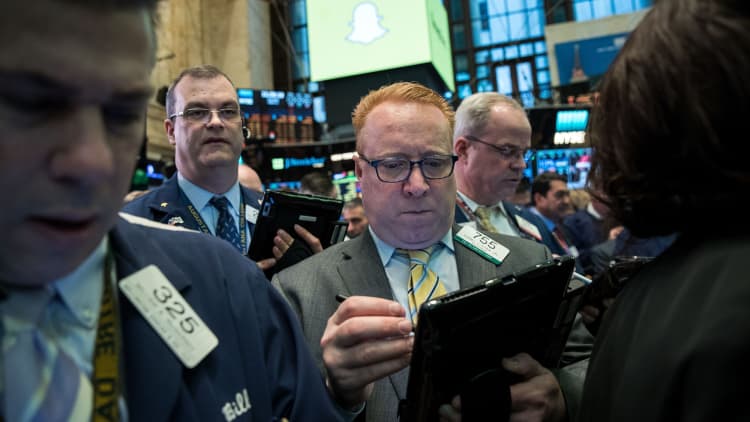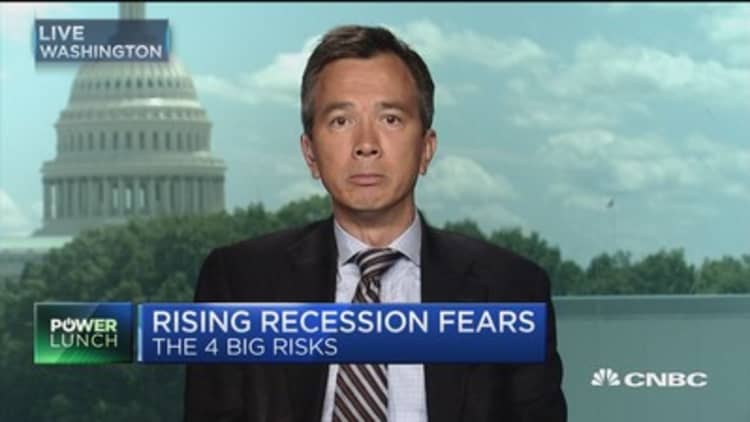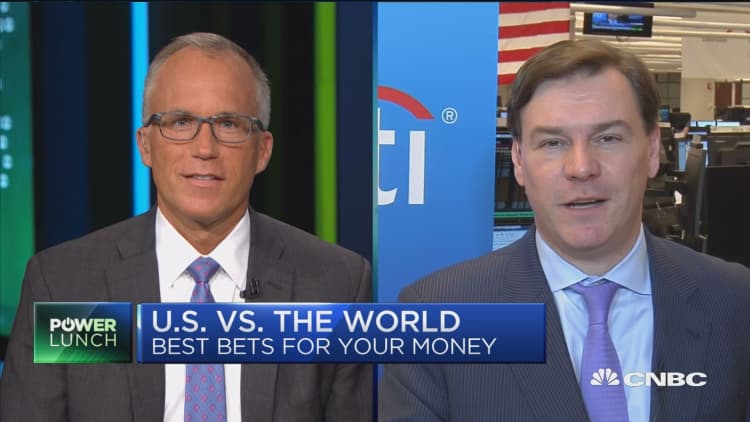
Stocks have sailed along for a year and a half without a significant correction, but analysts see increasing signs of trouble ahead.
Global strategists from Citigroup and JPMorgan both fired off warnings Monday about events that could affect the rally in equities. Citigroup pointed to rising rates as a threat, and JPMorgan analysts said they are concerned second-half earnings may not be as robust as the market is anticipating.
Stock prices continue to rise despite concerns about lofty valuations. The S&P 500's price-earnings ratio is 17.5 times forward 12 months earnings.
"I find it hard to put money to work here," said Thomas Lee, co-founder of Fundstrat. With major banks kicking off second-quarter earnings reports at the end of the week, Lee says earnings will be the "acid test" for stocks. While this quarter should be fine, he said there are doubts about how strong profits will be later in the year, despite high expectations.
The only seen two days of a 1 percent or greater decline this year – March 21 and May 17. The index was down 6 percent over a three-week period around the Brexit vote in June 2016, but it hasn't fallen more than 10 percent since the 14 percent correction that began in late 2015 and ended in February 2016. Year to date, the S&P is up 8.4 percent.

In the past two weeks, sovereign yields have risen amid a seeming sea change in thinking about global central banks and interest rate direction, which started with hawkish comments from European Central Bank President Mario Draghi. The has followed the lead of the German bund, and rates have gone from about 2.12 percent on June 26 to 2.37 percent. The Fed also has sounded hawkish, emphasizing that it is on track to both slow down bond buying and raise interest rates before the end of the year.
"Rising bond yields have started to worry investors with signs of increased volatility across a number of risk assets and emerging markets. Recent data have shown outflows from U.S. and European equities as well as from EM bond funds and reduced inflows to EM equities," Citi strategists wrote. But they also noted that earnings remain strong enough to support stocks for now.
Citi said the stock market could be at risk if there is a global economic slowdown coupled with softer earnings. Citi strategists also note that "monetary tightening could be a threat if central banks are perceived to have got ahead of the curve." The strategists also said it would be negative for investor confidence if central banks perceive they need to tighten policy because of asset price inflation.
"For now, however, the team believes that there is sufficient earnings momentum to warrant further gains in equity markets, particularly in Europe and Japan. With return expectations in other asset classes still at multi-year lows, it is hard to see major rotation out of equities into defensive assets just yet," they wrote. "The bull market in equities looks a bit old and tired, but it is not yet dead."
Global strategists at JPMorgan raised the flag on earnings, but pointed out that the second quarter should be strong. "We note that in the US, the negative to positive earnings pre-announcement ratio is down to 1.9x, its lowest level in six years," they wrote.
S&P 500 earnings are expected to be up 7.9 percent in the second quarter, following a 15 percent gain in first-quarter earnings, according to Thomson Reuters. The analysts said the first quarter benefited because the period a year ago was when the earnings recession in 2015 and 2016 troughed. They said the second quarter of 2016 was the last quarter of negative earnings growth and should make for easy comparison for this earnings season.
"[Second half] is where the problems could materialize in earnest," they wrote. The strategists said there are three factors to consider about the rest of the year. One is that expectations for second-half growth are elevated, and the comparisons to last year will be more difficult than in the first half. In the U.S., the strategists noted that consensus estimates are for earnings growth of 7 to 8 percent in the third quarter, when excluding commodities and 12 to 15 percent in the fourth quarter.
Secondly, pricing could be weaker in the second half, and global producer price inflation is signaling a slowing in second-half earnings growth. The third issue could be economic growth with the potential for slower China momentum and some mixed U.S. data.
Price-earnings ratios are vulnerable to a slowdown in earnings growth. But they also are vulnerable to rising yields, the strategists note. According to their report, world price to earnings is 26 percent more expensive than it was ahead of the Fed's tapering of quantitative easing in 2013.
The JPMorgan strategists warned in May about the potential for an equities consolidation and they recommended some profit-taking at the time.
"Interestingly, while EPS estimates have been lowered for Q2 and Q3 in the US, they have been raised for Q4. As a result, FY'17 forecasts have become more reliant on the delivery of Q4 earnings," they wrote.
Watch: Bull market thesis remains intact, says Belski



